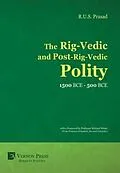The book critically examines and assesses the literary evidence available through Vedic and allied literature portraying the nature of Vedic polity, the functionalities of its various institutions, and the various social and religious practices. The book is not a narrative but critically examines the nature of changes in a host of these areas that occurred at each stage of Vedic polity from early Vedic period to post R ig-Vedic period. It outlines in historical perspective the various stages involved in the development of Vedic polity and Vedic canon and how the two processes have gone along together. It contains extensive discussions on political system and institutions, religious and social practices as they obtained during the Rig-Vedic and post Rig-Vedic periods. It provides a fresh approach to the cult of sacrifice and fire rituals practiced by Vedic Aryans along with an in-depth analysis of the Vedic view of Nationalism, Sovereignty and State as discernible from Vedic texts .The book also features an extensive discussion on the institution of kingship, administrative machinery, role of various entities in the polity including the Purohita, the Sabha and the Samiti, position of women, Varna system and features of tribal kingdoms, such as the Kuru-Panchalas and Kosala-Videhas. Isolating political and social aspects from the essentially religious character of Vedic literature, an attempt has been made to show with due corroboration that the tribal polity was not deficient in political content contrary to the stance of some scholars to depict Vedic Aryans as apolitical and inward looking.
The present book partakes both the current and previous scholarship on the subject but breaks a new path with its exclusive focus on the Rig-Vedic and Post Rig-Vedic polity, together with a balanced and objective assessment of their features. It brings all the relevant and connected issues on to one platform, and deals with them in a holistic manner. Its unique features include:
• The "Vedic Grid": a graphical representation and tabulations of the characteristics of each of the about 50 Vedic tribes, including information on the location of their habitat, their time line, the names of their chieftains and their linkage with priestly clans. • A special focus on the Second Urbanization taking place in the Gangetic valley between the 6th and 4th centuries BCE. It explains how towards the end of the later Vedic period, the polity underwent a change in political, social and economic spheres which blossomed later during the period of Mauryas. • Two appendices dealing with the theories of Aryan migration and the relationship of the Vedic Aryans with the Harappa culture and what can be ascertained by Vedic literature.
Autorentext
Dr. R.U.S. Prasad is currently engaged in post-doctoral research as an Associate in the Department of South Asian Studies, Harvard University. This book is culmination of more than three years of research at Harvard where he works with Professor Michael Witzel which was interspersed with research work in India. His research challenges the perception of some scholars that Vedic texts focus primarily on the religious and metaphysical aspects of Indian mind. Leveraging the robust framework of time and place, Dr. Prasad brings out the political and social aspects of the Aryan expansion as it transformed from a tribal, pastoral society to the emergence of the Kuru- Pancalas, the first large confederacy and beyond. Dr. Prasad holds a Doctorate degree from Jawaharlal Nehru University, India and a Master's degree in History and Economics from Patna University, India. His other notable research engagements include Stanford University, where he was a visiting research fellow at the Stanford Center for International Development (SCID) where he also contributed two Working Papers which were published by SCID. Dr. Prasad has held a variety of assignments under the Government of India including that of Secretary to Government of India as also as a Member of Telecom Disputes Settlement and Appellate Tribunal. He has worked as Expert/Consultant for two Switzerland based United Nations (UN) specialized agencies, viz. International Telecommunication Union (ITU) and Universal Postal Union (UPU). He is widely travelled and has participated in many international conferences as leader of Indian delegation. He has also written a book titled 'Resolving Disputes in Telecommunications- Global Practices and Future Challenges' which was published by Oxford University Press, India in 2011.
Inhalt
i) Acknowledgements; ii) Foreword iii) Abbreviations iv) Glossary v) Preface Chapter I - Introduction Vedic Age Dating of the R gveda Time-line of the later Vedic texts Composition of the R gveda and other Vedic texts Possible locations Chapter II - Sources and Methodology; Chapter III - Development of Vedic Canon and Vedic Polity; Chapter IV - Vedic Concepts of Nationalism and Sovereignty Chapter V - Vedic Ra¯s t r a; Chapter VI - Important R gvedic tribes: a) Anus; b) Druyus; c) Purus; d) Turvasas; e) Yadus; f) Other Rig-Vedic tribes; Chapter VII - Vedic Grid Chapter VIII - Post R gvedic tribes; Chapter IX - Political System and Institutions during the R gvedic and Post R gvedic Periods a) Institution of Kingship b) Origin of Kingship c) Selection or election of a King d) Deposition of a King e) The King's Consecration f) The King's duties g) Subsidiary Political Institutions and Administrative Apparatus Chapter X - The R gvedic and Post R gvedic Social Practices a) Social Characteristics b) Status of Women c) Varn a System Chapter XI - Vedic Values and Religious Practices a) Concept of R ta b) Cult of Sacrifice Chapter XII - Tribal Kingdoms a) TheKuru-Pan¯ca¯la Ascendancy b) Kosala-Videha Realm Chapter XIII - Features of the Post R gvedic Period Chapter XIV - Second Urbanisation Chapter XV- Summary and Conclusions. Appendix I: Vedic Aryans - Migrants or Indigenous; Vedic Aryans and the Harappan Culture. Appendix II: A Brief Outline of Vedic Literature- The R gveda, The Yajur-Veda, The Sa ¯ma-Veda, The Atharva-Veda, The Bra¯hman as, The A¯ran yakas, The Upanis ads, The Su¯tras. Bibliography List of Tables List of Maps
